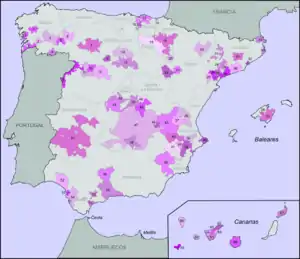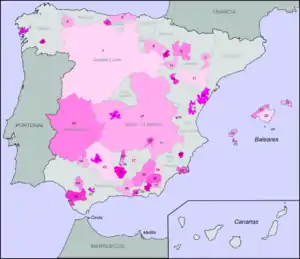Cava (Spanish wine)
Cava (Spanish pronunciation: [ˈkaβa], plural Cavas) is a sparkling wine of Denominación de Origen (Designation of Origin) status from Spain, made using the traditional method. It comes in white (blanco) or rosé (rosado), and the main grape varieties used are Macabeo, Parellada and Xarel·lo

The Cava D.O. encompasses more than 38,000 hectares of vineyards and more than 6,800 winegrowers. The vast majority of all Cava is produced in the Penedès area in Catalonia; and industry’s home is Sant Sadurní d'Anoia. Cava is also produced in other areas of northern, north-eastern, south-western and eastern Spain Aragon, Castile and León, Extremadura, La Rioja, Navarre and Valencia. [Link to footnote: Statistics and The Wineries | D.O. Cava]
Cava is the Spanish D.O. with the highest exports: more than 60% of sales of this wine are international. Its 370 associated wineries have a presence in over 100 countries.
Nearly 250 million bottles of Cava were produced in 2019, using more than 320 million kg of grapes.
Origin of the name
The name “Cava” derives from the Spanish word cava, meaning cave or cellar, since caves were used for storing and aging wine in barrels or bottles. The name, already commonly used at that time for sparkling wine, was officially adopted in 1972, by the newly formed Sparkling Wine Regulatory Council.
Production process
Produced according to the traditional method (also called méthode champenoise or méthode traditionelle), which it shares with Champagne, Cava requires a double fermentation process.
The first fermentation of the base wine, also known as alcoholic fermentation, is mostly carried out in large stainless-steel tanks whose temperature is carefully controlled.
The different base wines are blended, and tirage liqueur (a mix of yeast and sugar) is added, causing the second fermentation inside the same bottle which is eventually bought by the consumer.
Carbon dioxide is produced during this fermentation, forming the signature bubbles. The bottles are stored horizontally “on the lees” (in contact with dead yeast cells), and are gradually tilted upside down and turned, so that the yeast sediment is left in the neck (“riddling”). The sediment is removed (“disgorgement”) by chilling the bottles so that the lees in the neck freeze, and are ejected by pressure when the cap is taken off.
Next the dosage, or expedition liqueur (liquid usually consisting of wine and sugar), is added to the Cava, to make up the small amount of liquid lost during the disgorging process.
The amount of sugar in the dosage determines which type of Cava that will be produced. Brut Nature Cava is the driest and is made without any added sugar (this Cava contains 0-3 grams per litre of natural sugar only).
Finally, the cork is put in place, secured by a metal crown cap and wire cage, and the label is added, with the D.O. Cava stamp.
Cava requires a minimum bottle-aging time of 9 months for young Cavas (de Guarda), and at least 18 months for Cavas de Guarda Superior.

Grape varieties
As well as Macabeo, Xarel·lo and Parellada, other varieties are also used, such as Chardonnay and Pinot Noir and, to a lesser extent, Subirat Parent (Malvasia). For rosé Cavas, red grape varieties Garnacha, Monastrell and Trepat are used.
Types and categories of Cava
Cavas are classified in two different ways: according to their sugar content, in grams per litre (type), and according to their aging time (category).
These are the seven types of Cava. depending on the amount of sugar added to the expedition liqueur:
● Brut Nature: up to 3 g of natural sugar per litre, without added sugar
● Extra Brut: 3 - 6 g of sugar per litre
● Brut: 6 - 12 g of sugar per litre
● Extra Seco: 12 - 17 g of sugar per litre
● Seco: 17 - 32 g of sugar per litre
● Semi-Seco: 32 - 50 g of sugar per litre
● Dulce: more than 50 g of sugar per litre
Depending on the time spent aging in the bottle, a Cava belongs to one of the following categories.
- Cava de Guarda: minimum 9 months’ aging.
- Cava de Guarda Superior Reserva: minimum 18 months of aging.
- Cava de Guarda Superior Gran Reserva: minimum 30 months' aging.
- Cava de Guarda Superior de Paraje Calificado: minimum 36 months’ aging.
In 2015 a new category of Cava was created, Cava de Paraje Calificado, to refer to those Cavas with a minimum of 36 months of bottle-aging. These are produced from vineyards with special characteristics of location and terroir that set them apart from the rest.
History
Cava was originally inspired by the wines of Champagne. The first bottles of Cava, made using the traditional method of second fermentation in the bottle, were produced in Sant Sadurní d’Anoia in 1872 by Josep Raventós.
After the vineyards of the area were decimated by phylloxera in the 1887, a group of farmers and producers from Sant Sadurní d’Anoia replanted their vineyards with native white grapes and started produced quality sparkling wines, using the traditional Cava coupage trio of Macabeo, Xarel-lo, and Parellada. This group included Raventós, his son Manuel, and Marc Mir.
In 1932 an initial definition of sparkling wines appeared within the first Spanish wine regulations, but did not include Cava until 1959; 10 years afterwards, it was formally recognised.
In 1972, facing conflict with France over the protected designation of origin (P.D.O.) for Champagne, the Sparkling Wine Regulatory Council of Spain was set up. This body approved the designation of cava to name the Spanish sparkling wine, settling the dispute and supporting the name used locally for this "cava wine".
By the 1980s, over 100 million bottles of Cava were being sold around the globe every year.
Production area
Cava originates in the Catalan region of Penedés (provinces of Barcelona and Tarragona), whose municipality, San Sadurní d'Anoia, is the most important production centre, and is popularly known as “the capital of Cava”. But Cava is also produced in other areas of Spain, mostly in the north and north-east.
Four different Cava-producing areas can be identified; in two of these, more specific sub-areas constitute the zone:
● Comtats de Barcelona (Valls d'Anoia-Foix, Serra de Mar, Conca del Gaià, Serra de Prades and Pla de Ponent, in Catalonia)
● Valle del Ebro (Alto Ebro, near Logroño, in País Vasco/Navarre/La Rioja; and Valle del Cierzo, near Zaragoza, in Aragon)
● Viñedos de Almendralejo (region of Tierra de Barros, Badajoz, in Extremadura)
● Zona de Levante* (municipality of Requena, in Valencia)
*Name to be determined.
Climate
The fact that Cava is produced in a more temperate climate than other sparkling wines means that the wines are drier, but also richer in nuances, so they combine perfectly with almost every type of cuisine in the world.
Sustainability
D.O. Cava is one of the most forward-thinking wine regions in Spain when it comes to sustainability, with demand increasing strongly – production of organic Cava rose by 35% in 2019. [link to footnote: Statistics and The Wineries | D.O. Cava]. From 2025, all Cavas will be produced organically.
Some of the measures that Cava wineries are implementing currently include reduced chemical treatments in the vineyards, as well as careful conservation and development of biodiversity; responsible water management; reduction of CO2 footprint and greenhouse gas emissions; renewable energy sources; and use of eco-friendly recyclable and compostable materials, both for bottles (reduced weight) and packaging (recycled paper, non-polluting inks, plastics of vegetable origin, etc).
Almost 40,000 of the 113,000 hectares of vineyards in Spain – more than one-third – that are certified as organic (data from 2019) belong to Cava D.O.
Regulatory Council
The Cava Regulatory Council (an organisation that answers to the Spanish Ministry of Agriculture, Fisheries and Food) is responsible for guaranteeing the quality standards of the wines of Cava D.O., and for ensuring compliance with its regulatory specifications.
The council controls all elements of the Cava production process, from harvesting the grapes to bottling the final product. It is also responsible for safeguarding the prestige of the D.O. and for promoting its presence in global markets.
All brands under the D.O. Cava must display their quality seal on each bottle, to show that they meet all the D.O.'s strict regulations and criteria.
The headquarters of the Cava Regulatory Council is located in Villafranca del Penedés.
Pairing with food, and used in cocktails
Thanks to its ability to refresh the palate with every sip, its fine bubbles, and its dry taste rich in nuances, Cava is perfect to accompany all kinds of dishes. This quality Spanish sparkling wine reinforces the richness of flavours, balances the intensity of seafood dishes, and simplifies the complexity of soups and creamy sauces.
Younger, fresher Cavas pair well with all kinds of starters or raw foods such as sushi, tartare or oysters, while the longer-aged categories, such as Guarda Superior Reserva, are a perfect accompaniment to rice and red meat dishes.
Rosé Cavas are an ideal match for white-rind cheeses and beef, while the notes of jam and red fruits make them ideal to accompany desserts.
In addition, Cava is a versatile ingredient in cocktails: it can be used to prepare both classics such as Sangria, Mimosa and Black Velvet, or used in innovative drink mixes.

